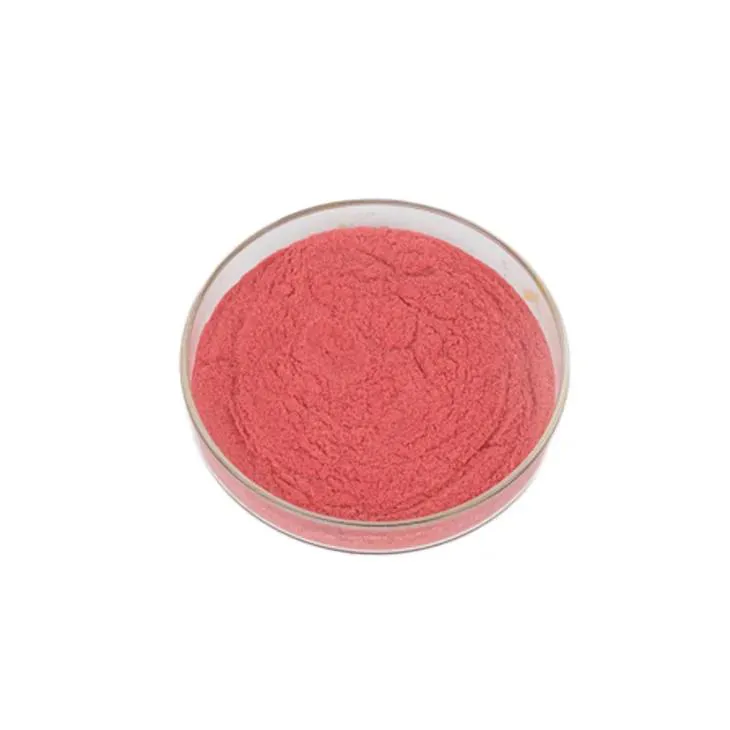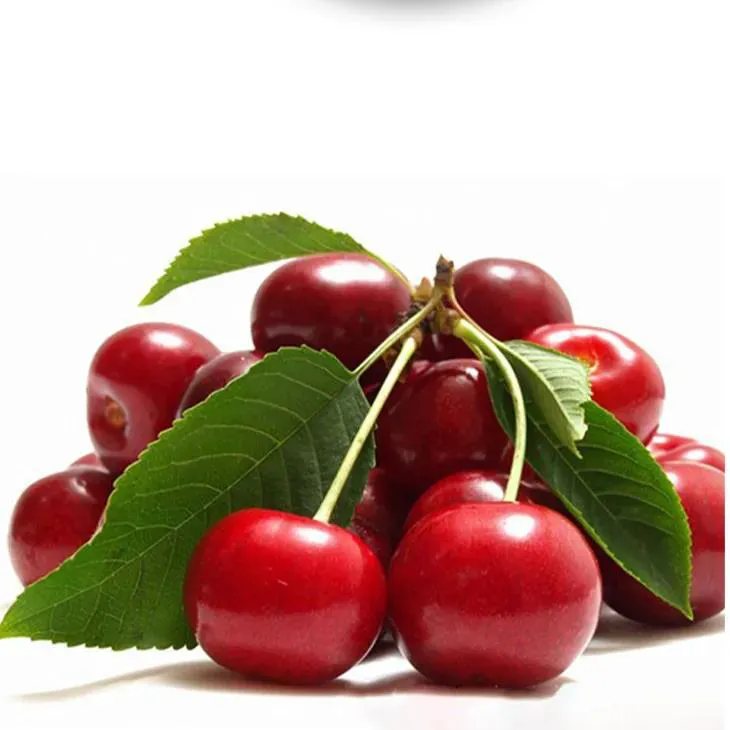- 0086-571-85302990
- sales@greenskybio.com
The process of extracting pure vitamin C from acerola juice powder.
2024-11-28

1. Introduction to Acerola Cherry
Acerola cherry, also known as Barbados cherry, is a small, bright - red fruit native to Central and South America, the Caribbean, and southern Texas. It is renowned for being one of the richest natural sources of vitamin C. Acerola cherry juice powder is a convenient form of this fruit, which retains many of its beneficial properties.
The properties of acerola cherry are quite remarkable. It has a high antioxidant capacity, mainly due to its high vitamin C content. Vitamin C is an essential nutrient for humans, playing crucial roles in immune function, collagen synthesis, and antioxidant defense. Acerola cherry juice powder also contains other beneficial compounds such as flavonoids, carotenoids, and minerals, which can contribute to overall health.

2. Importance of Extracting Pure Vitamin C from Acerola Juice Powder
Extracting pure vitamin C from Acerola Juice Powder has several significant implications. In the food industry, pure vitamin C can be used as a natural preservative, antioxidant, and nutrient fortifier. It can prevent the oxidation of fats and oils in food products, thereby extending their shelf life. In addition, it can enhance the nutritional value of foods, especially in products such as juices, cereals, and dairy products.
In the medicine field, vitamin C is widely used for its immune - boosting properties. Pure vitamin C obtained from Acerola Juice Powder can be used in the production of dietary supplements, which are beneficial for people with weakened immune systems, such as the elderly, pregnant women, and those recovering from illness. Moreover, it may also have potential applications in the treatment of certain diseases, such as scurvy, and in promoting wound healing due to its role in collagen synthesis.
In the cosmetics industry, vitamin C is a popular ingredient. It can help to brighten the skin, reduce the appearance of wrinkles, and protect the skin from environmental damage. Pure vitamin C extracted from acerola juice powder can be incorporated into various cosmetic products, such as creams, serums, and masks, providing a natural and effective way to improve skin health.

3. Extraction Methods
3.1 Solvent Extraction
Solvent extraction is one of the commonly used methods for extracting vitamin C from acerola juice powder. In this method, a suitable solvent is selected to dissolve the vitamin C present in the juice powder. Ethanol and water are often used as solvents, either alone or in combination.
The process typically involves the following steps:
- First, the acerola juice powder is mixed with the solvent in a suitable container. The ratio of powder to solvent is carefully adjusted to ensure optimal extraction. For example, a ratio of 1:10 (powder:solvent) may be used in some cases.
- Then, the mixture is stirred or agitated for a certain period of time. This helps to increase the contact between the powder and the solvent, facilitating the dissolution of vitamin C. Stirring may be carried out at room temperature or at a slightly elevated temperature, depending on the solubility characteristics of vitamin C in the chosen solvent.
- After that, the mixture is filtered to separate the liquid extract containing vitamin C from the solid residue. Filtration can be done using filter paper or a filtration device such as a Buchner funnel.
Advantages of solvent extraction include its relatively simple operation and low cost. It can be easily scaled up for industrial - scale production. However, it also has some limitations. One limitation is that the solvent may also extract other compounds along with vitamin C, which may require further purification steps. Additionally, some solvents may have safety and environmental concerns.
3.2 Chromatography Techniques
Chromatography techniques offer a more precise way of extracting pure vitamin C from acerola juice powder. There are different types of chromatography that can be used, such as high - performance liquid chromatography (HPLC) and ion - exchange chromatography.
In HPLC, the acerola juice powder extract is injected into a chromatographic column filled with a stationary phase. A mobile phase is then pumped through the column at a constant flow rate. Vitamin C, along with other components in the extract, interacts differently with the stationary and mobile phases, resulting in their separation. The eluted fractions containing vitamin C can be collected for further use.
Ion - exchange chromatography works based on the principle of ion exchange. The extract is passed through a resin column with charged groups. Vitamin C, depending on its ionic form, will interact with the resin and be selectively retained or eluted.
Advantages of chromatography techniques are their high selectivity and ability to obtain high - purity vitamin C. They can effectively separate vitamin C from other closely related compounds. However, they are relatively complex and expensive compared to solvent extraction. They also require specialized equipment and trained personnel to operate.

4. Purification Steps
After the extraction process, purification steps are crucial to obtain high - purity vitamin C. One common purification method is crystallization. In this process, the vitamin C - rich extract is concentrated by evaporation or other means to a supersaturated state. Then, by carefully controlling the temperature, pH, and other conditions, vitamin C crystals start to form. These crystals can be separated from the mother liquor by filtration or centrifugation.
Another purification method is recrystallization. This involves dissolving the initially obtained crystals in a suitable solvent and then repeating the crystallization process. Recrystallization can further remove impurities and improve the purity of vitamin C.
Ultrafiltration can also be used for purification. It is a membrane - based separation process that can separate molecules based on their size. By using an appropriate ultrafiltration membrane, larger impurity molecules can be retained while vitamin C, which is relatively small in size, can pass through the membrane.

5. Potential Applications
5.1 Food Applications
In the food industry, pure vitamin C extracted from acerola juice powder can be used in a variety of ways. As mentioned earlier, it can be used as a preservative. For example, in the production of canned fruits and vegetables, adding vitamin C can prevent browning and spoilage. It can also be added to meat products to inhibit lipid oxidation, which improves the quality and shelf life of the products.
Vitamin C can also be used as a nutrient fortifier in foods. In breakfast cereals, for instance, adding vitamin C can enhance the nutritional profile of the product. It can also be added to fruit juices and beverages to increase their vitamin C content, providing consumers with a more nutritious option.
5.2 Medical Applications
In medicine, pure vitamin C has multiple applications. As a dietary supplement, it can help boost the immune system. It can also be used in the treatment of scurvy, a disease caused by vitamin C deficiency. In addition, recent research has suggested that vitamin C may have potential benefits in the treatment of other diseases such as cancer, although more research is needed in this area.
Vitamin C is also important for wound healing. It is involved in the synthesis of collagen, which is a key component of connective tissue. By promoting collagen synthesis, vitamin C can help wounds heal faster and more effectively.
5.3 Cosmetic Applications
In the cosmetics industry, pure vitamin C is a valuable ingredient. It can be used in skin - care products to brighten the skin. Vitamin C inhibits the production of melanin, which is responsible for skin pigmentation. By reducing melanin production, it can help to even out skin tone and give the skin a more radiant appearance.
It can also be used to reduce wrinkles. Vitamin C stimulates the production of collagen in the skin, which helps to improve skin elasticity. As we age, the production of collagen decreases, leading to the formation of wrinkles. By supplementing with vitamin C, the skin can become more firm and smooth.
Moreover, vitamin C has antioxidant properties, which can protect the skin from damage caused by free radicals. Free radicals are unstable molecules that can cause oxidative stress in the skin, leading to premature aging, wrinkles, and other skin problems. By using products containing vitamin C, the skin can be better protected from these harmful effects.
FAQ:
What are the properties of acerola cherry and its juice powder?
Acerola cherry is known for being a rich source of vitamin C. Its juice powder likely retains many of the beneficial properties of the fruit. It may have a characteristic color, flavor, and nutrient profile. The powder form is convenient for storage and further processing. It may also contain other bioactive compounds along with vitamin C, such as antioxidants, flavonoids, and minerals.
What are the advantages of solvent extraction for vitamin C from acerola juice powder?
Solvent extraction can be relatively simple and cost - effective. It can efficiently separate vitamin C from the complex matrix of acerola juice powder. It allows for large - scale extraction in some cases. The solvents can be chosen based on their selectivity for vitamin C, which can lead to a relatively pure extract. However, one disadvantage is that the solvent may need to be removed completely to obtain pure vitamin C, and there may be potential for solvent residues if not properly managed.
What are the limitations of chromatography techniques in vitamin C extraction from acerola juice powder?
Chromatography techniques can be expensive and require specialized equipment and trained personnel. They may also be time - consuming, especially for large - scale extractions. Additionally, the sample preparation steps can be complex, and there may be issues with reproducibility. However, they offer high selectivity and can produce very pure vitamin C extracts, which is a significant advantage in certain applications.
Why are purification steps important in obtaining high - purity vitamin C from acerola juice powder?
Purification steps are crucial because acerola juice powder contains many other components besides vitamin C. These impurities can affect the quality, stability, and effectiveness of the vitamin C. For example, in the food, medicine, and cosmetics industries, high - purity vitamin C is required. Purification helps to remove any potential contaminants, such as other sugars, proteins, or unwanted organic compounds, ensuring that the vitamin C meets the necessary purity standards for its intended applications.
What are the potential applications of pure vitamin C extracted from acerola juice powder in the food industry?
In the food industry, pure vitamin C can be used as a nutrient supplement in various products such as juices, cereals, and confectionery. It can act as an antioxidant to prevent spoilage and maintain the freshness of food products. Vitamin C can also enhance the color and flavor stability of certain foods. Additionally, it may be used in functional foods to provide health benefits to consumers, such as boosting the immune system.
Related literature
- Extraction and Purification of Vitamin C from Natural Sources"
- "Acerola Cherry: A Rich Source of Bioactive Compounds"
- "The Role of Vitamin C in Food, Medicine and Cosmetics"
- ▶ Hesperidin
- ▶ Citrus Bioflavonoids
- ▶ Plant Extract
- ▶ lycopene
- ▶ Diosmin
- ▶ Grape seed extract
- ▶ Sea buckthorn Juice Powder
- ▶ Fruit Juice Powder
- ▶ Hops Extract
- ▶ Artichoke Extract
- ▶ Mushroom extract
- ▶ Astaxanthin
- ▶ Green Tea Extract
- ▶ Curcumin
- ▶ Horse Chestnut Extract
- ▶ Other Product
- ▶ Boswellia Serrata Extract
- ▶ Resveratrol
- ▶ Marigold Extract
- ▶ Grape Leaf Extract
- ▶ New Product
- ▶ Aminolevulinic acid
- ▶ Cranberry Extract
- ▶ Red Yeast Rice
- ▶ Red Wine Extract
-
Boswellia Serrata Extract
2024-11-28
-
Longan Extract
2024-11-28
-
Andrographis Paniculata Extract Powder
2024-11-28
-
Alisma Extract
2024-11-28
-
Chaste Berry Extract
2024-11-28
-
American Ginseng Root Extract
2024-11-28
-
Diosmin
2024-11-28
-
Angelica sinensis extract
2024-11-28
-
Quercetin
2024-11-28
-
Pueraria Lobata Extract
2024-11-28





















